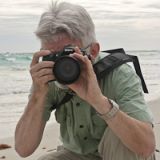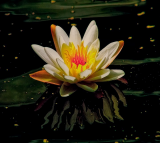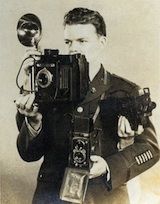- Forum
- General Discussion | Introductions | Off Topic Forum
- Photography General Discussion
- ISO settings in your camera for every day shooting?
ISO settings in your camera for every day shooting?
-

- Rob pix4u2
- Photo Guru
- Nikon N90s & FE film & D90 and D90 digital bodies
- Followers: 196
- Posts: 4204
-
Points:
30
Post #117484
Remember to engage brain before putting mouth in gear
Rob Huelsman Sr.
My Facebook www.facebook.com/ImaginACTIONPhotography
-

- steveheap
- Snapobsessed
-
- Canon 5D Mark II
- Followers: 17
- Posts: 447
-
Points:
73
Post #117485
I have noticed that if I go far enough down with my ISO I end up in L 0.3, then L 0.7 then L 1.0 . Which would be equal to ISO 100?
I'm not 100% sure which camera you have, but it sounds to me like there would be a step before you see L0.3, which would probably be ISO100. I think these numbers are under-exposing by 1/3 stop, 2/3 stop and then a full stop - ie they are part of exposure compensation rather than a change in the ISO. I know that Canon has some special menu setting to go to 50 ISO (ie it is not normally available from the buttons on the camera) and I had always assumed that it was some way of under (or is it over) exposing and then processing the file to give you a normal image as though the ISO had really been set for 50.
Steve
-

- Henry Peach
- Apprentice
-
- I currently use a 5DII or Sony Nex-3 most of the time.
- Followers: 50
- Posts: 2925
-
Points:
16
Post #117487
Scott Grant wrote: OH and why do they change the ISO name from a number to "L 0.3" ??
"L" for low. They usually do it on the "high" end too. This shows it's a processing effect, a push or a pull , rather than actually changing the sensitivity of the camera.
-
 Topic Author
Topic Author
- Scott Grant
- Lone Wolf
-
- Nikon D7000
- Followers: 20
- Posts: 196
-
Points:
10
Post #117489
Post #117734
Well it is because they are not an actual ISO value but a simulated ISO value outside of the sensors true operating parameters. Dont use either the High or Low on your camera the images are greaty defraded. It is like the difference between the Optical Zoom and the Electronic Zoom on P&S cameras, if you go past the Optical you get photos with jagged edges. Same goes for the HiLo BS.Scott Grant wrote: I see, well if you ask me. Why change the pattern, simplify things and keep the numbers rather than getting all fancy with letters and fractions.

BTW what does "L" mean?
-

- Henry Peach
- Apprentice
-
- I currently use a 5DII or Sony Nex-3 most of the time.
- Followers: 50
- Posts: 2925
-
Points:
16
Post #117740
Scott Grant wrote: I see, well if you ask me. Why change the pattern, simplify things and keep the numbers rather than getting all fancy with letters and fractions.

BTW what does "L" mean?
L for low.
Because it's not really a change in ISO. It's a change in processing. There are different paths to the same destination, but it's still good to remember what path you are on.
Stops are how photographers measure exposure and light. 1/3rd stop is a slight change, but often noticeable to the human eye.
-
 Pt+
Pt+ - Alex
- PT Founder
-
- Canon EOS R5 | EOS R | M6 II
- Followers: 1795
- Posts: 4785
-
Points:
48943
-

- Stealthy Ninja
- Moderator
-
- Fuji X stuff and a 1DsIII for some reason
- Followers: 982
- Posts: 16300
-
Points:
6837
Post #117828
-

- cod
- Snapobsessed
- Nikon D300S
- Followers: 71
- Posts: 484
-
Points:
1165
Post #117833
-

- Henry Peach
- Apprentice
-
- I currently use a 5DII or Sony Nex-3 most of the time.
- Followers: 50
- Posts: 2925
-
Points:
16
Post #117934
-

- cod
- Snapobsessed
- Nikon D300S
- Followers: 71
- Posts: 484
-
Points:
1165
Post #118058
Henry Peach wrote: I'm always surprised when people mention noise being an issue from DSLRs. I make very large prints from 4 digit ISO shots, and while I can see some noise when pixel peeping, I would call the prints effectively noise-less. I've got some hanging next to 20"x prints from 6x6 and 6x7 Tmax 100, and they make the medium format film prints look gritty.
I see a very noticeable difference in noise between ISO 200 and 1600 on my D300S. Now, I shoot RAW, so that's before processing. I can usually eliminate the noise with software but its usually at the cost of some loss in sharpness/detail. ISO 1600 shots are perfectly acceptable once well processed and I don't hesitatte to use it when necessary. All else being equal, though, I believe the lower ISOs will produce better images. Whether or not that difference is noticeable under the specific viewing conditions is another question. I certainly agree with Henry that one can produce good quality large prints even at higher ISO values.
Post #118258
-

- KCook
- Photo Elder
-
- Canon EOS 50D and Olympus E-P5
- Followers: 1325
- Posts: 5410
-
Points:
32913
Post #146171
Canon 50D ISO trial
Kelly
-

- robbie
- Apprentice
-
- D200,665nm D200,720NM D70,D7000
- Followers: 72
- Posts: 2768
-
Points:
25
-

- MLKstudios
- Banned
-
- D800 ;-)
- Followers: 72
- Posts: 4480
-
Points:
2
Post #146376
Matthew L Kees
MLK Studios Photography School
www.MLKstudios.com
[email protected]
"Every artist, was once an amateur"
- Forum
- General Discussion | Introductions | Off Topic Forum
- Photography General Discussion
- ISO settings in your camera for every day shooting?
Latest Reviews
The Olympus Pen E-P7 is an affordable micro four thirds mirrorless camera with 4K video capabilities, a 20.3MP sensor, and 121 focus points, making it a solid entry-level camera for beginners.
The Panasonic G9 II is a 25.2-megapixel micro four thirds camera with numerous features that make it punch out of its weight class, like 779 AF points, 5.8K video, and weather sealing.
The Fujifilm XT5 is a 40MP mirrorless camera capable of 6.2K video at 30p. With those specs, it’s an ideal choice for photographers needing a camera to pull double duty for imaging and video.
The Canon EOS R100 is an entry-level mirrorless camera introduced in 2023. But just because it’s an entry-level camera doesn’t mean it’s a bare-bones camera. Find out why in this review!
Forum Top Posters
-
1Scotty 5 posts
-
2CharleyL 5 posts
-
3Razky 4 posts
-
4Roman Omell 4 posts
-
5Pat White 3 posts
-
6Ruby Grace 3 posts
-
7TCav 3 posts
-
8Colorado Mike 3 posts
-
9J Photo Man 3 posts
-
10Jim Photo 3 posts
Latest Articles
The Canon 6D Mark II might be an older DSLR, but that doesn’t mean it isn’t a good option for 2024. In fact, this budget-friendly camera is a powerhouse for stills and videos.
In this guide to the bokeh effect, you’ll learn what bokeh is and the factors involved in creating it. You’ll also explore some beautiful example images to spark your creativity with bokeh!
Upgrade your kit in 2024 with the best intermediate camera on the market! The question is, what camera fits the bill? We’ve got three top options for you to choose from in this buyer’s guide.
The best photography jobs right now are a mix of tried-and-true gigs like wedding photography and new jobs highlighting AI’s capabilities, travel, and videography.
The Olympus Pen E-P7 is an affordable micro four thirds mirrorless camera with 4K video capabilities, a 20.3MP sensor, and 121 focus points, making it a solid entry-level camera for beginners.
Starting a photography business is one thing; sustaining your business over a long period of time is another. Use the tips in this professional photography guide to build something with longevity!
The Panasonic G9 II is a 25.2-megapixel micro four thirds camera with numerous features that make it punch out of its weight class, like 779 AF points, 5.8K video, and weather sealing.
Cinematic photography is an interesting genre that combines photographic and videographic skills along with effective storytelling techniques. The result? Highly impactful images!


















